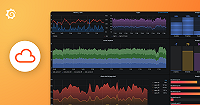Important: This documentation is about an older version. It's relevant only to the release noted, many of the features and functions have been updated or replaced. Please view the current version.
Pyroscope ingester
The ingester is a stateful component that writes incoming profiles first to on disk storage on the write path and returns series samples for queries on the read path.
Incoming profiles from distributors are not immediately written to the long-term storage but are either kept in the ingester’s memory or offloaded to the ingester’s disk. Eventually, all profiles are written to disk and periodically uploaded to the long-term storage. For this reason, the queriers might need to fetch samples from both ingesters and long-term storage while executing a query on the read path.
Any Pyroscope component that calls the ingesters starts by first looking up ingesters registered in the hash ring to determine which ingesters are available. Each ingester could be in one of the following states:
PENDING
The ingester has just started. While in this state, the ingester does not receive write or read requests.JOINING
The ingester starts up and joins the ring. While in this state, the ingester does not receive write or read requests. The ingester loads tokens from disk (if-ingester.ring.tokens-file-pathis configured) or generates a set of new random tokens. Finally, the ingester optionally observes the ring for token conflicts, and once resolved, moves to theACTIVEstate.ACTIVE
The ingester is up and running. While in this state, the ingester can receive both write and read requests.LEAVING
The ingester is shutting down and leaving the ring. While in this state, the ingester doesn’t receive write requests, but can still receive read requests.UNHEALTHY
The ingester has failed to heartbeat to the hash ring. While in this state, distributors bypass the ingester, which means that the ingester does not receive write or read requests.
To configure the ingesters’ hash ring, refer to configuring memberlist.
Ingesters write de-amplification
Ingesters store recently received samples in-memory in order to perform write de-amplification. If the ingesters immediately write received samples to the long-term storage, the system would have difficulty scaling due to the high pressure on the long-term storage. For this reason, the ingesters batch and compress samples in-memory and periodically upload them to the long-term storage.
Write de-amplification is the main source of Pyroscope’s low total cost of ownership (TCO).
Ingesters failure and data loss
If an ingester process crashes or exits abruptly, all the in-memory profiles that have not yet been uploaded to the long-term storage could be lost. There are the following ways to mitigate this failure mode:
- Replication
Replication
By default, each profile series is replicated to three ingesters. Writes to the Pyroscope cluster are successful if a quorum of ingesters received the data, which is a minimum of 2 with a replication factor of 3. If the Pyroscope cluster loses an ingester, the in-memory profiles held by the head block of the lost ingester are available at least in one other ingester. In the event of a single ingester failure, no profiles are lost. If multiple ingesters fail, profiles might be lost if the failure affects all the ingesters holding the replicas of a specific profile series.



